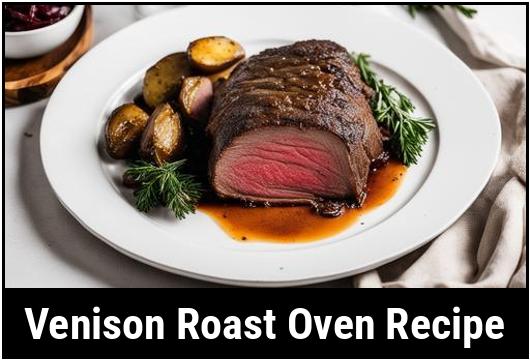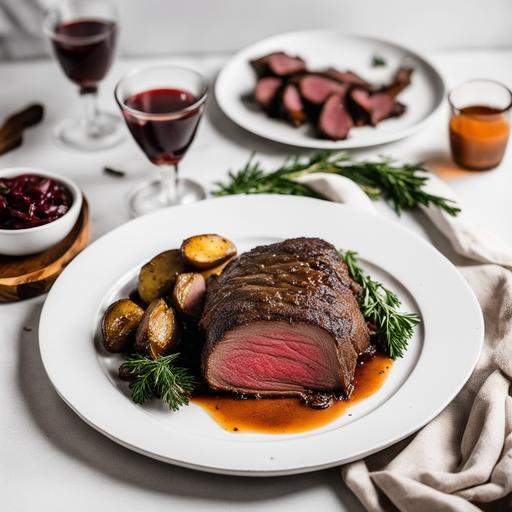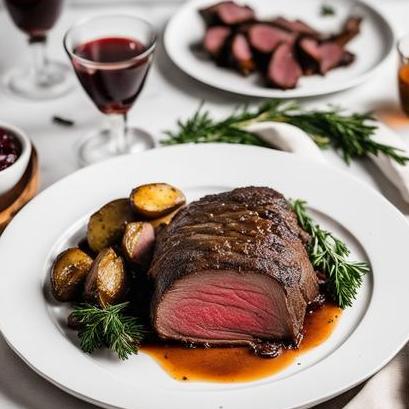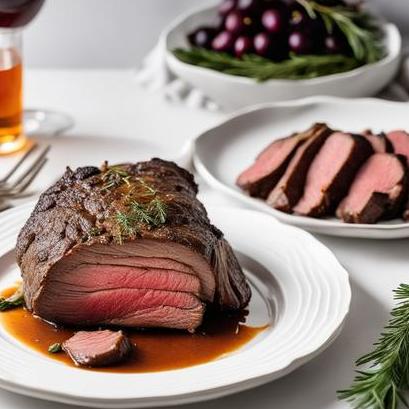
The Ultimate Guide To Cooking A Perfect Venison Roast In The Oven
Venison, also known as deer meat, is a lean and flavorful protein that can make for a delightful meal. Among the many ways to prepare venison, a classic method is roasting it in the oven. This comprehensive guide will take you through each step of the process, from selecting the right cut to serving up a succulent and tender venison roast. So let’s dive in!
Understanding the Science of Venison Roasting
Before we delve into the culinary aspects, it’s important to understand the science behind cooking a venison roast. Venison is a lean meat, which means it has minimal fat marbling. This low fat content gives it a distinct flavor but can also make it susceptible to drying out when cooked. However, with the right techniques, you can achieve a moist and tender venison roast that will impress your guests.
Selecting the Perfect Venison Roast
When it comes to selecting the perfect venison roast, there are a few key factors to consider. First and foremost, freshness is crucial. Look for cuts that are bright red, indicating that the meat is fresh and not past its prime. Additionally, aim for a cut that has a layer of fat on the outside, as this can help keep the meat moist during cooking.
There are various cuts of venison that work well for roasting, such as the shoulder, loin, or hindquarters. Each cut has its own unique characteristics, so choose based on your personal preferences and the cooking time you have available. For this guide, we will focus on a venison loin roast, known for its tenderness and flavor.
Cleaning and Preparing the Venison Roast

Before cooking your venison roast, it’s essential to clean and prepare it properly to ensure optimal taste and texture. Begin by rinsing the roast under cold water to remove any residual blood or bone fragments. Gently pat it dry with paper towels, being careful not to squeeze or manipulate the meat excessively.
Next, take a moment to examine the roast and trim any excess fat or silver skin. Venison fat can have a strong flavor, so removing most of it will allow the natural flavors of the meat to shine through. However, do leave a thin layer of fat to keep the roast moist during cooking.
Marinating for Flavor and Tenderness

Marinating the venison roast is an excellent way to infuse it with flavor and tenderize the meat. A marinade essentially consists of an acidic or enzymatic liquid combined with aromatic herbs, spices, and oils. The acid or enzyme breaks down the connective tissues within the meat, resulting in a more tender roast.
A popular marinade for venison roast includes ingredients like red wine, olive oil, fresh herbs (such as rosemary and thyme), garlic, and black pepper. Combine the ingredients in a bowl and pour the marinade over the venison roast. Ensure the meat is fully submerged and marinate it in the refrigerator for at least 4-6 hours, or even overnight for a more robust flavor.
Tips for Achieving Optimal Roasting Results

Roasting a venison roast to perfection requires attention to detail and a few helpful tips. Here are some key points to keep in mind:
1. Preheat the Oven and Choose the Right Pan
Preheating the oven is key to achieving even cooking. Set your oven to 325°F (163°C) and allow it to reach the desired temperature before placing the roast inside. Additionally, choose a roasting pan that is large enough to comfortably fit the roast with some space around it. A rack inside the pan will elevate the roast, allowing heat to circulate evenly.
2. Searing for a Beautiful Crust
To create a savory and attractive crust on your venison roast, searing it before roasting is the way to go. Heat a cast-iron skillet or a heavy-bottomed pan over medium-high heat. Coat the venison roast with a little oil and sear it on all sides until a golden-brown crust forms. This step not only enhances the flavor but also helps seal in the meat’s juices.
3. Using a Meat Thermometer
Achieving the desired level of doneness is crucial when roasting venison. Since venison is lean, it can quickly go from perfectly cooked to overdone. To avoid this, invest in a reliable meat thermometer to monitor the internal temperature of the roast. For a medium-rare roast, aim for an internal temperature of 135°F (57°C), which will rise a few degrees during resting.
4. Let It Rest
Resting the venison roast after roasting is essential to allow the juices to redistribute and be reabsorbed by the meat. Once the roast reaches the desired internal temperature, remove it from the oven and tent it loosely with aluminum foil. Let it rest for at least 10-15 minutes before carving. This step ensures a moist and tender roast.
A Classic Venison Roast Oven Recipe

Now that we’ve covered the essential steps and tips, let’s dive into a classic recipe for venison roast in the oven. This recipe will help you create a mouthwatering dish that is sure to impress.
Ingredients:
- 3-pound (1.4 kg) venison loin roast
- 1 cup red wine
- ¼ cup olive oil
- 3 cloves garlic, minced
- 2 sprigs fresh rosemary
- 2 sprigs fresh thyme
- 1 teaspoon black pepper
- Salt to taste
Instructions:
- Rinse the venison roast under cold water to clean it thoroughly. Pat it dry with paper towels.
- In a bowl, combine the red wine, olive oil, minced garlic, rosemary, thyme, black pepper, and salt.
- Place the venison roast in a shallow dish and pour the marinade over it, ensuring the meat is fully submerged. Cover the dish and refrigerate for at least 4-6 hours (or overnight for enhanced flavor).
- Preheat your oven to 325°F (163°C).
- Heat a cast-iron skillet or heavy-bottomed pan over medium-high heat. Add a small amount of oil and sear the venison roast on all sides until a golden-brown crust forms.
- Transfer the roast to a roasting pan fitted with a rack, if available.
- Insert a meat thermometer into the thickest part of the roast, being careful not to touch the bone.
- Place the roasting pan in the preheated oven and roast until the internal temperature reaches 135°F (57°C) for medium-rare doneness (adjust cooking time based on your desired level of doneness).
- Once the roast reaches the desired temperature, remove it from the oven and tent it loosely with aluminum foil. Let it rest for 10-15 minutes to allow the juices to redistribute.
- After resting, carve the roast into thin slices against the grain and serve with your favorite sides.
Variations and Serving Suggestions
While the classic venison roast recipe is highly satisfying, you can explore various flavor profiles and serving options once you’re comfortable with the basics. Here are some inspiring variations and serving suggestions:
- Red Wine Reduction Sauce: Prepare a sumptuous sauce by deglazing the pan with red wine, minced shallots, and a splash of beef broth. Reduce the liquid until it thickens, strain, and serve alongside the venison roast.
- Fruit Glaze: Create a delightful balance of sweet and savory by brushing the roast with a glaze made from reduced fruit juice (such as cranberry or blackberry), honey, and Dijon mustard during the last 15 minutes of cooking.
- Herb Crust: Enhance the flavors by coating the seared roast with a mixture of fresh breadcrumbs, chopped herbs (such as parsley, thyme, and rosemary), olive oil, and grated Parmesan. Gently press the mixture onto the roast before roasting.
- Serving Suggestions: Pair the venison roast with creamy mashed potatoes, roasted root vegetables, or a refreshing citrus salad. The rich and tender venison will shine alongside these flavorful accompaniments.
Enjoy the Culinary Delight of Venison Roast
Cooking a venison roast in the oven is a rewarding endeavor that yields a succulent and flavorful meal. By following this comprehensive guide, you’ll be equipped with the knowledge and skills necessary to create a show-stopping venison roast that will impress your family and friends. Remember to adapt the cooking times based on the size and cut of the roast, and feel free to experiment with different marinades and seasonings.
So roll up your sleeves, embrace the culinary joy of preparing a venison roast, and savor the wonderful flavors that this delightful meat offers. Bon appétit!
Sources
- Roast Venison – An Easy, Straightforward Guide On Roasting Venison Cuts
- The Best Venison Roast Recipe » Homemade Heather
- Venison Roast Recipe (Oven) – Cleverly Simple
- Venison Roast Recipe – North American Whitetail
FAQS On Venison Roast Oven Recipe
What Is A Venison Roast?
A venison roast is a cut of meat from a deer that is typically cooked as a main dish.
How Should I Prepare The Venison Roast Before Cooking?
Before cooking, it is recommended to thaw the meat if frozen and marinate it for at least 24 hours in a mixture of oil, herbs, and spices to enhance the flavor and tenderness.
What Temperature Should I Cook The Venison Roast At?
The ideal temperature for cooking a venison roast is 325°F (162°C). This allows for the meat to cook evenly and retain its moisture.
How Can I Tell If The Venison Roast Is Done Cooking?
The best way to ensure a perfectly cooked venison roast is to use a meat thermometer. The internal temperature should reach 145°F (63°C) for medium-rare, 160°F (71°C) for medium, and 170°F (77°C) for well done.
Can I Use The Drippings From The Roast To Make A Gravy?
Yes, the drippings from the venison roast can be used to make a delicious gravy. Simply add flour and beef broth to the drippings and cook over medium heat until thickened. Adjust seasoning to taste.



